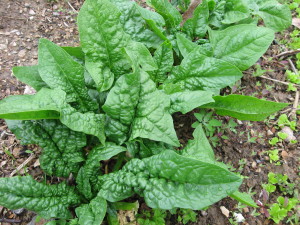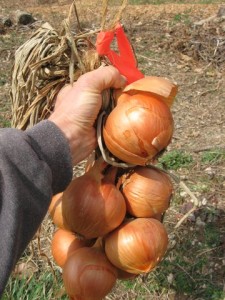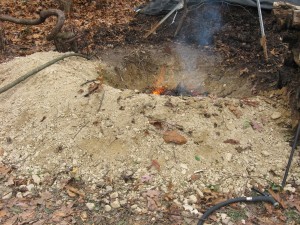For this month’s installment of writing about humans accepting ownership of and by their lives and contexts, I want to piggyback on last month’s thoughts spurred by my 40th birthday trip to Nebraska (with a few stops along the way) and expand a little on those notions of our species exercising a role of ecological promoter in the places we inhabit. Let’s follow along with the itinerary of the trip, using some of those stops as examples to help us understand a point or two.
Our first stop was Dayton, Ohio, where we used the available sleeping surfaces in my cousin Steve’s house, and enjoyed some conversation. Actually, that conversation started in a Lebanese restaurant. It was amazing to see a restaurant full of Arabic folks eating the (delicious!) food they loved in a city in the middle of the heartland. But how many times has this story been replicated here? My own ancestors brought their German life to Pennsylvania (and their Swedishness to Wisconsin, their Hungarian selves to Connecticut). Dayton is not just one of the American melting pots, it is also hurting, and it represents some of the illness that plagues our society. Saturday morning before we left for Missouri, the Dads stopped for a fast food breakfast. That not appealing to me for multiple reasons, I stayed in the car and ate some of the food we had brought. While I munched, a woman appeared on the intersection with a cardboard sign and some extremely bright pink stretch pants. She set up shop by the light pole, dancing and swinging her arms and pointing to her sign. There I was, with a box full of food and a few minutes on my hands. Observing that a pedestrian made it past her without getting into a sticky situation, all my excuses were used up. Just before we got back on the road I dashed across traffic and handed her an apple and a granola bar. She seemed surprised and grateful, and didn’t even have to interrupt her cell phone call. How many different things are wrong with this picture? We’ll get to more detail on Dayton on the way back home, when we had a bit more time to get out into the city.
Through the sea of black soil that is the Midwest we sailed until we arrived in La Plata, Missouri, where my dear friend Adam is living amongst some folks loosely gathered around the concept of living regeneratively in the land, and doing so in patterns that also restore human relationship in community. Blah, blah, blah…what do those words mean? Well, near as I can tell the first folks of this mind to move there had as their goal to establish a low-tech Ghandian-style ashram that was for the purpose of pursuing justice with regard to humans relating to each other and the rest of the universe, with the idea also that it would be a place that could be looked to as an example of such right living, primarily through on-site trainings and such. Technologies to be used would be carefully chosen to promote life and community as much as possible with as little harm as possible. Speaking of possible, they called themselves the Possibility Alliance. Folks they knew and others soon heard of this initiative and were attracted to it, some for the short term, some longer term. Adam ended up there after a protracted solo bike tour of his home state (MO), and he says if he hadn’t stumbled upon this collection of folk, he would have concluded that there was nothing appealing enough in the state to him to keep him there. Adam now lives on an adjacent property sort of pursuing his own hero’s journey, but with frequent contact with the originals. Several other homesteads and Catholic Worker houses and sundry have been magnetized to the neighborhood as they work out similar themes and recognize how vital a functional neighborhood is to truly living out these converging visions. I won’t burden a person with details, even though that is where the high ideals get worked out. Think goat cheese, composting toilets, chickweed salad, no electricity…candlelit conversation with thoughtful minds (Adam and his wonderful partner) uncrowded by screen time is the precious setting I carried away from there and am still treasuring. Germaine to our current discussion is what this collection of people and their choices represent thematically, which I am going to call an attempt at regeneration. The word is deceptive, though, in the sense that it seems to imply a return to some former state of health. This is an unfair accusation. In fact the participants realize they are trying to achieve health for their selves and their context moving forward. This requires many reaches into the past, some acceptance of present customs, and a whole lot of attentive care as the fresh challenges arrive. But lest you think they have cracked the code, be aware that they feel their challenge keenly. 11 years in, the neighborhood is facing upheaval as exhaustion and other factors have the original founders looking for a new start in Maine.
After said candlelit talking, an excellent (truly dark…aah!) night’s rest and a tour in the morning, and after a lightning round of garden-in-a-box (i.e., Jason shares and explains some seeds), we got into the very high-tech Prius and zoomed off to the Platte River area of Nebraska to see the cranes, ostensibly the whole point. See my last writing for coverage of that experience. Here I want to talk about the conservation center we visited, the Rowe Sanctuary. I can’t say how the thing is funded…I know it was established with some kind of endowment, and I know we paid some sizable fees for the places we occupied in the blinds (worth it!). But beyond that it is hard to say exactly how it fits into the economy at large. So far as I can see, to be paid for is a nice visitor’s center, managed areas to suit the cranes’ needs for safe roosting, possibly incentives to local land managers for creating good crane conditions in the area, and staff time to oversee all of this. This doesn’t add up to a huge chunk of change when you consider the size of the surrounding economy, even locally to that area. I am pretty sure, in fact, that the crane gawkers bring more money in to the area than the management activities require. Surely it’s worth a little tweak to cropping patterns, a load of gravel for the lot every so often, a fresh coat of paint every few years, some heavy machinery work on the sandbars and a gaggle of humans bustling around between offices with papers under their arms! It’s not hard for an individual to see the value. But getting the system to acknowledge values we might hold personally is a terrific challenge. The Rowe folks must feel in constant peril of their project being tossed in the trash at the first hint of economic trouble, because in moments when panic starts to rise, suddenly setting money and land “aside” starts to look like a luxury, and that is, at least in part, what their model depends on. This is too blunt of a characterization, but I see the “Wildlife Sanctuary” model as often practiced to be an extension of an “us and them” notion of doing right by our contexts, where humans are the ‘us’ and all wild species are the ‘them.’ The only things, in practical terms, keeping us from wiping them out completely in the interest of commandeering all available resources for our own use are a sense of loss we know we’ll experience if they disappear forever (which is also selfish) and a moral obligation we seem to feel to not completely, totally, eliminate all of the other species on the planet except ourselves and the ones we know we can make to serve us. To be fair, there is more nuance here…Rachel Carson and her ilk helping us see that “nature” provides many needful services and that patterns we see in “nature” help us recognize when we’ve thrown things out of balance. Furthermore they kindle in us a sense that our fellow species and their communities have intrinsic value. These things are true and I laud them. To quote the fine woman directly, “…for all people, the preservation of wildlife and of wildlife habitat means also the preservation of the basic resources of the earth…” I would elect Rachel Carson if I could!
I put the word ‘nature’ in quotes above because the very use of the word implies an othering impulse. This is the prevailing model, I am afraid, of those of us who are trying to take responsibility for our effects on the natural world. The governing idea is that we should stop short of taking it all, but implied there is the acceptability–or at least inevitability–that the lands and other resources we make use of are used in ways that exclude and degrade the integrity of the places where the use happens. Put in plainer terms, we assume farms replace or displace wild species and communities, and that saving islands of “unspoiled nature” is good enough, or is the best we can do. There is a current of denial in this. As if by “saving” some fragment of the original system, we can escape responsibility for having blithely and ignorantly decimated the vast bulk of it. It is time we move beyond the denial stage of grief and fully face the losses we are bringing on our environs and by extension ourselves in our arrogance. People who have done their grieving work well can more honestly face the mess they are left with and make the best of it. That is where we need to get to. The “leave some room for nature” mode of thinking may also be thought of as an extension of the notion of original sin…humans are automatically and irreparably bad, and any limits to that badness are accomplished by hard work and strong ethics. You see why I called it a burden last month?
I am going to label this the Conservation model. I don’t think we can do without it in some form. It would do us so much good if we could conserve way more of our wild lands and keep our hands off of them to the extent possible. But it is decidedly not good enough. If we can’t honor our neighbor species and their relationships and learn to participate in their lives as members of the whole in the places we live, we all suffer that loss, and it is my belief that that expresses perhaps the majority of what is wrong with our culture. We conservationists seem embarrassed by our own need for sustenance. Certainly you don’t hear polite conservationists talking much about it. I admit I am always startled when I am reading some nature writer and learn that they keep chickens. I am taken by surprise by their need to eat, and the realization that they face the same conundrums I do and haven’t gotten much further ahead in solving the puzzle than me. I find I wish that biologists would write about their diets. Barbara Kingsolver is the notable and honorable exception to this unmentioned rule of silence. Of course this would open up some conceptual conflicts and draw some disappointment and consternation, but we’d best get into that and through it…going around it isn’t getting us there. Nature isn’t a beautiful, “unspoiled” place to visit or leave alone, nature is the whole world, including us. To the extent we realize this and start to live this way, I also think conservation in the conventional sense will feel more natural and less burdensome to us. If that’s right, then separating ourselves from the wild, even supposedly for its own sake, is counterproductive to the goal of conservation. When people have meaningful (better yet useful) contact with wild species in their daily lives, they can cherish them and sacrifice for them, generation after generation.
Enter Calamus Outfitters on the Switzer ranch, near Burwell, NE. Last month’s writing got into some detail on this place…I will try not to repeat! But last month I couldn’t fit in some things about their endeavor that I think relevant to this discussion. After our Safari jeep tour through their soulful, real and gritty prairie ranchlands, I had the good fortune of sitting down with Sarah–who with her brother Adam is currently doing the bulk of the running of the place–for a little Q and A. I did the Q part, she the A. I’ll incorporate some of that exchange as we go. Several times since being home from the trip folks have asked me what exactly it was about the Calamus Outfitters story I find so compelling. It could be that I just fell for the prairie environment. I have a mantra I tell myself when I am in a new locale, especially one rich in biological and geological interest: “Don’t fall in love…don’t fall in love…” I said that in Maine when we were there a few years back, I said it in Highland County Virginia in February, and I said it this time, especially on my walks through the land both evenings during which I noticed that walking in this landscape would encourage excellent posture as a person was constantly encouraged to stretch a little taller and see a bit more of the horizon. I was just thankful it was overcast the whole time we were there so I couldn’t see the stars!
The real answer is the sense of integration (let’s call this one the Integration model) I picked up from them. It would seem they have found a way to continue doing what they love by monetizing other facets of the place they love, and their family’s several-generation history running a farm business in the place renders them capable of seeing the value of managing these elements (the prairie plants for grazing and the prairie chickens for gawking at) in ways that ensure their flourishing over the long term. When asked to respond to the notion of “sustainability” on their ranch and with the outfitting, Sarah mentioned a few product choices and feeding scraps to the chickens, even planting nitrate-loving annual crops to reclaim manure nutrients from cattle wintering areas (less than 1% of acreage in any given year), but then came the interesting part: she mentioned that they’ve been grazing the same land for 100 years, and it’s better now then it was 50 or even 30 years ago. There it is.
It intrigued me to see how natural “naturalism” was to these folks. Though the elder Switzer (Sarah and Adam’s father) confessed on video that the first time he went out in the blind he was astonished at the mating rituals of the prairie chickens. He had lived there all his life, had always had prairie chickens in his grasses, and had never taken the time to know them this way. He expressed hope that his grandchildren would not make the same mistake. For her part Sarah, according to Adam, actually went to university with the idea of studying environmental science or ecology or wildlife biology or some such but quit the program because of how antagonistic all the professors were to agricultural land uses. Conservationists take note: think what the typical attitudes almost cost the world that time. Fortunately it didn’t end there. During the jeep tour Sarah and Adam treated us to, their knowledge of all aspects of the land including wild species ran so obviously deep, and Sarah especially was able to talk about it lucidly…a breath of fresh air to me: the doubter in the conventional crowds of both agriculture and conservation.
Given this comprehensive interest on their part, I didn’t know how Sarah would answer when I asked whether the outfitting/ecotourism thing was a fun and exciting idea they wanted to pursue for its own sake or a compromise they were willing to make to stay on the land. Truly, she explained, it was a compromise. The cattle market had been poor and Adam was tired of agriculture-themed jobs that involved a lot of travelling and prevented his daily participation in ranch life, which was what he truly yearned for. Getting desperate for other sources of income that allowed him to stay home, he used his gift for hunting and opened their ranch to guided hunts, mostly for turkey and deer. From there it has expanded to ecotourism and river trips, such that the hunting has faded in importance. At this point, she says, their ranching is again profitable, but if they want opportunities to be there for the generation coming on, then the outfitting must remain a part of the mix. Yes, their first love is ranching, but this other stuff is a nonetheless fulfilling way to earn that extra money, she says…when people appreciate it! When asked if there are things that get under their skin, she admitted it is “very, very hard” when visitors are critical or unhappy with the way they do things on the ranch. It would seem that is one of the perils of opening up their home in this way. Though it wasn’t their first choice, it is, she contends, a good fit for their personalities and for their ranch (especially in terms of relative location to migratory flyways, grouse ranges, and the Calamus river), and seems to her to have all worked out for a divinely guided reason, even matching daydreams she used to entertain as a girl of showing people around their place, introducing them to its wonders and pleasures.
After the success they have seen in this business, they seem to have won over their skeptical ranching neighbors, and feel they are in a supportive environment in that way. Economically, I worry. Not because of their specific business model, but because of the way the damming of the Calamus river (the lake is visible from the ranch) has changed the whole land economy of the area. Cattle prices, she declares, won’t even pay the interest on the purchase price of land with any view of the lake. So land use in the area, in her words, “will change!” At this point she claimed they are the only ranchers around that haven’t had to sell land along the road for houses to pay the bills. There will be a decline in ranch-style land management in the area. As English sheep farmer James Rebanks said in a March 1 Op-Ed in the NY Times, “Economists say that when the world changes people will adapt, move and change to fit the new world. But of course, real human beings often don’t do that. They cling to the places they love, and their identity remains tied to the outdated or inefficient things they used to do, like being steel workers or farmers. Often, their skills are not transferable anyway, and they have no interest in the new opportunities. So, these people get left behind.” A hateful situation for ranchers and prairie chickens, as last month’s writing details. As other ranchers find they can’t afford to stay, the mutual help between neighbors that ranching life depends on will be harder to find, and the seasons lonelier. The Switzer clan have other reasons to resent the lake. Historically their family could raise corn for feeding in only one place around: the river bottomland that disappeared underwater when the dam was completed in the 80’s. She called this event a hole in their hearts that will never be filled, but they are learning to take advantage of the new circumstances. In fact, Sarah seemed to think that although they are operating at capacity and can’t really manage any expansion of their outfitting business, the opportunity would be there. If they built bigger, she is confident they could fill the spaces. Furthermore, in response to a question of mine about including local cuisine (I bought a book about Sand Hills Cuisine out of their store) in their offerings, she thought people would eat that up (pun intended…by me, not her), and it would be a great opportunity for someone, but not a good fit for what they are trying to accomplish. All in all, in fact, her opinion seemed to be that they are right about exactly where they want to be. When asked to describe her ideal scenario moving forward, she was plain about it: “To keep doing what we’re doing. We’re together. It’s a good life.”
Beat that, next stop! It couldn’t possibly. We headed out to St. Louis for some birding and a visit to the City Museum. I think I described most of what is needed to say about this last month; suffice it to say that we visited a waterfowl refuge of some sort that was created (not preserved) out of farmland spoiled by flood deposits. It is carefully managed for the promotion of wetlands wildlife, most notably huntable waterfowl. It was impressive. One wonders what would happen if similar initiatives could be proliferated at strategic points along the flyways and at breeding grounds, etc. Could we see a resurgence of the wild abundance this continent was known for before the Western mind took it over? I will call this model Farming the Wild. Yes, it is a fraught concept, but if we take our grief work (mentioned above) seriously and face reality, we will see that we’ve been mucking about in these systems inadvertently since the beginning; time to take responsibility, albeit with the greatest of humility and with open minds. My mind, for its part, was full to bursting with these thoughts and concepts as we made our way back to Dayton.
Arriving there earlier in the day this time, we had time for a nice dinner together at their home, then a walk through the neighborhood. After the ecologically rich, if complicated experiences we had just passed through, I admit Dayton was a bit of a shock. Nothing out of the ordinary here, just a fully realized wealthy urban American cityscape from street level. A natural spectacle of its own, in a way. As the cranes were individuals to each other but indistinguishable to us, so every house there runs together in my mind in a unified image of shorn grass out front, tasteful shrubs and herby perennials, nicely accented trim, car in drive. Over, and over, and over again. Miles and miles of them! After several blocks, we came to a park, which included a huge sand box with Tonka trucks, excellently maintained play equipment including a fountain garden for kids to splash in, and a few well-placed trees. Indeed, I think this was the first play park I have ever seen which benefited from the foresight to place the jungle gym under a tree for shade! Brilliant. The place was absolutely crawling with kids. Not all of Dayton is so financially endowed–my cousin and cousin-in-law declare it a racially and economically divided city, as many old industrial towns are. In their neighborhood, though, people write angry letters to the editor when a Goodwill looks to locate in a new shopping center. ‘We pay good tax dollars’ they complain. Hmm. Anyway, a few blocks further and we found our second destination of the evening, where I enjoyed an unexpected treat, in that usually I don’t enjoy ice cream beyond your standard Mint Chocolate Chip (the mint cuts that gummy sensation in the throat, or at least distracts from it). But here they had a flavor I had to try: Bourbon Pecan Chocolate Chip. And friends, it was every bit as good as it sounds! We are talking detectable whiskey flavor, pecan halves, nice chips and no gumminess detected. Odd we weren’t in Tennessee or Mississippi, but I am not complaining.
It is, however, to my point about urban Dayton. I am going to call it the Where Are We? model of biological management. Truly, there was nothing left of what had been there, and no visible attempt had been made to bring it back. Organisms that can survive these conditions are celebrated, all others are absent. We could have been anywhere. It is not that I didn’t enjoy the visit. Good family time. It is just that what has been accomplished there makes me sad beyond measure when I stop to think.
From there it was homeward bound. We arrived back at our beloved Tangly Woods and into the waiting arms of our own precious ones. Over the following days I had to think about how our home place relates to the other models we experienced on our Crane odyssey. It is a wilder and kinder place than Dayton, but shares something of its sensibility of order in places. It lacks the extreme of simplified technological involvement shown at the Possibility Alliance, but we are working towards a similar place. We don’t have an endowment or the clarity of focus that the Rowe Sanctuary possesses, but we experience wonder in those moments when the forces of nature make their spectacles. We are not business people and have a much shorter history in this land, but like the Switzers we pay attention and try to respect and integrate what we find around us and the systems that support our lives. Like the waterfowl preserve, we are aiming to rehabilitate ailing farmland and bring it back in line with a more natural trajectory. This is the place we claim and hope to be claimed by; it is our opportunity to reintegrate our lives with the soil, atmosphere, and water cycles of this planet we all share, one place at a time.

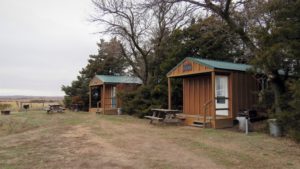
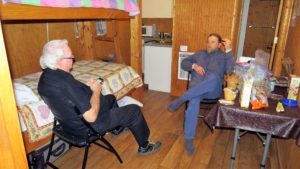 I start the writing for this month (March) from a cabin I am sharing with my father and father-in-law at Calamus Outfitters located on the Switzer Ranch near Burwell, Nebraska. We are just past the middle of a 10-day road trip that is the celebratory gift Janelle gave me on the occasion of my 40th birthday, which occurred exactly 6 months ago yesterday (9/29)! I know, I know, happy birthday to me. I got sung to by the other guests at dinner last night. They even made a feeble attempt at harmony! I was the youngest person in the room, a situation that suits me well, especially when I am in a reflective mood. Peers can be distracting.
I start the writing for this month (March) from a cabin I am sharing with my father and father-in-law at Calamus Outfitters located on the Switzer Ranch near Burwell, Nebraska. We are just past the middle of a 10-day road trip that is the celebratory gift Janelle gave me on the occasion of my 40th birthday, which occurred exactly 6 months ago yesterday (9/29)! I know, I know, happy birthday to me. I got sung to by the other guests at dinner last night. They even made a feeble attempt at harmony! I was the youngest person in the room, a situation that suits me well, especially when I am in a reflective mood. Peers can be distracting.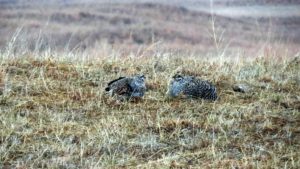
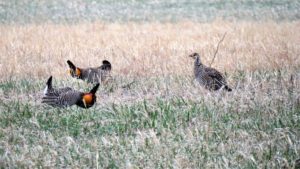 We are in Burwell to see prairie grouse—the Sharp-tailed Grouse and the Greater Prairie Chicken—as they perform their yearly collective pre-mating ritual at their special stomping grounds (literally) known as leks. The ritual involves lots of noises and motions on the part of the male grouse that seem rather silly to us, but which clearly are of great assistance to the lady grouse in deciding with whom to mate. They are all so occupied with this that humans seeking to look in on their business can do so from blinds located quite near the leks. This morning as dawn was almost breaking we snuck into old broken-down school buses with windows removed and watched in amused wonder as the Sharp-tailed Grouse flew in, then strutted their stuff while light came to the prairie. We will do the same for the Greater Prairie Chicken tomorrow, to our delight I am sure.
We are in Burwell to see prairie grouse—the Sharp-tailed Grouse and the Greater Prairie Chicken—as they perform their yearly collective pre-mating ritual at their special stomping grounds (literally) known as leks. The ritual involves lots of noises and motions on the part of the male grouse that seem rather silly to us, but which clearly are of great assistance to the lady grouse in deciding with whom to mate. They are all so occupied with this that humans seeking to look in on their business can do so from blinds located quite near the leks. This morning as dawn was almost breaking we snuck into old broken-down school buses with windows removed and watched in amused wonder as the Sharp-tailed Grouse flew in, then strutted their stuff while light came to the prairie. We will do the same for the Greater Prairie Chicken tomorrow, to our delight I am sure.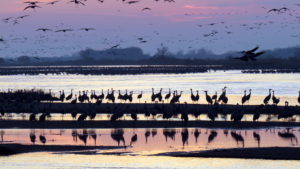
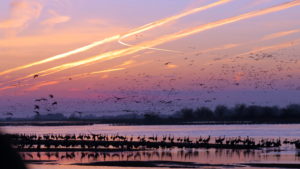 As entertaining as this is, and as beautiful as the birds are, this is not the primary reason we are in the Great Plains. Janelle’s idea for this trip came as a response to one of the few items on my “bucket list,” which was to witness the migration stopover of the Sandhill Cranes on the Platte River in central Nebraska. Up to 500,000 cranes pass through there in any given year on their way from wintering grounds in Texas and Mexico to their breeding grounds in the upper Midwest through Canada and the Arctic. For millennia, the Platte River valley has offered them respite from the grueling journey, and their life cycle relies on stopping for a month or more, depending on weather conditions, to rebuild energy reserves before heading on. I have always been fascinated with biological spectacles, especially migratory (how well I remember sitting for an hour or more on the lawn and watching the ribbons of migrating grackles passing thirty or fifty feet overhead and stretching as far as I could see in both directions), so as I have heard about this one over the last several years I have developed a desire to be here when it happens. I guess I mentioned it often enough that Janelle took me seriously! I am very grateful. Part of my desire also stems from something like whimsy, since I used to have a recurring dream of large, fantastical, heavily plumed birds on migration descending from the sky into my parents’ yard. We would converse together, the birds and I, though I don’t remember anything we talked about (They were kind enough, but a bit aloof, as I recall). This crane thing in Nebraska seemed the best match to experiencing in waking time a dream I had savored.
As entertaining as this is, and as beautiful as the birds are, this is not the primary reason we are in the Great Plains. Janelle’s idea for this trip came as a response to one of the few items on my “bucket list,” which was to witness the migration stopover of the Sandhill Cranes on the Platte River in central Nebraska. Up to 500,000 cranes pass through there in any given year on their way from wintering grounds in Texas and Mexico to their breeding grounds in the upper Midwest through Canada and the Arctic. For millennia, the Platte River valley has offered them respite from the grueling journey, and their life cycle relies on stopping for a month or more, depending on weather conditions, to rebuild energy reserves before heading on. I have always been fascinated with biological spectacles, especially migratory (how well I remember sitting for an hour or more on the lawn and watching the ribbons of migrating grackles passing thirty or fifty feet overhead and stretching as far as I could see in both directions), so as I have heard about this one over the last several years I have developed a desire to be here when it happens. I guess I mentioned it often enough that Janelle took me seriously! I am very grateful. Part of my desire also stems from something like whimsy, since I used to have a recurring dream of large, fantastical, heavily plumed birds on migration descending from the sky into my parents’ yard. We would converse together, the birds and I, though I don’t remember anything we talked about (They were kind enough, but a bit aloof, as I recall). This crane thing in Nebraska seemed the best match to experiencing in waking time a dream I had savored.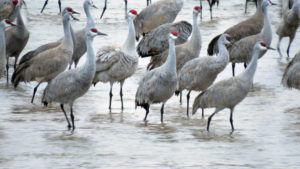

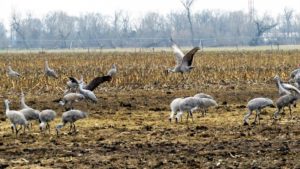 I think it’s useful now to highlight something the observant might already have picked up. As the cranes fly out to forage each morning, they forage in fields, by which I mean agricultural fields (mostly corn and soy) and cattle pastures. 60% of their diet on these annual stopovers is one food: gleaned waste corn from monocultures, of which the total population is said to consume 1,600 tons annually. Why is this ancient wild bird eating modern corn? The answer is simple and two-fold: because their old foods are too diminished, and because it’s there. This ancient bird, it turns out, is happily omnivorous and likes corn rather well. In fact, given the changes in the Platte River Valley due to intensive management of the Platte river for irrigation, municipal, and industrial interests as well as conversion of land for agriculture, it is likely that without the corn available the cranes would not find enough food to bulk up satisfactorily for their journey north, and the species could suffer declines. Furthermore, the changes in seasonal river flow have disrupted natural flooding cycles that keep sandbars in the river cleared of shrubs and trees—clear sandbars being critical crane roosting features—such that conservationists have taken to using heavy machinery to clear the resurgent vegetation artificially. Think of the implications of this if you will: Because of our interference in their ecosystem, they now depend on us for support. This is a perfect example of the Permaculture concept “Burden to the Intervenor.” I don’t know if this feels heavy to you, but it sure does to me. Is this a burden we want to keep carrying? Is this a burden we will indefinitely be able to carry? To borrow from the old gospel song: How, I wonder, does one lay such a burden down by the riverside? What else might we have to lay down? Into what new life would we be baptized?
I think it’s useful now to highlight something the observant might already have picked up. As the cranes fly out to forage each morning, they forage in fields, by which I mean agricultural fields (mostly corn and soy) and cattle pastures. 60% of their diet on these annual stopovers is one food: gleaned waste corn from monocultures, of which the total population is said to consume 1,600 tons annually. Why is this ancient wild bird eating modern corn? The answer is simple and two-fold: because their old foods are too diminished, and because it’s there. This ancient bird, it turns out, is happily omnivorous and likes corn rather well. In fact, given the changes in the Platte River Valley due to intensive management of the Platte river for irrigation, municipal, and industrial interests as well as conversion of land for agriculture, it is likely that without the corn available the cranes would not find enough food to bulk up satisfactorily for their journey north, and the species could suffer declines. Furthermore, the changes in seasonal river flow have disrupted natural flooding cycles that keep sandbars in the river cleared of shrubs and trees—clear sandbars being critical crane roosting features—such that conservationists have taken to using heavy machinery to clear the resurgent vegetation artificially. Think of the implications of this if you will: Because of our interference in their ecosystem, they now depend on us for support. This is a perfect example of the Permaculture concept “Burden to the Intervenor.” I don’t know if this feels heavy to you, but it sure does to me. Is this a burden we want to keep carrying? Is this a burden we will indefinitely be able to carry? To borrow from the old gospel song: How, I wonder, does one lay such a burden down by the riverside? What else might we have to lay down? Into what new life would we be baptized?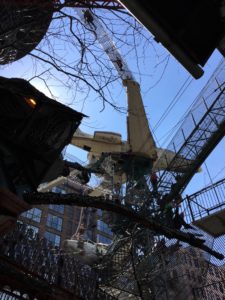
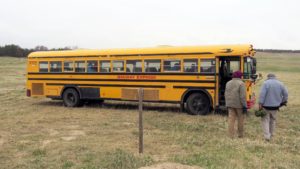 The riot of crane calls and the sounds of the Sharp-tailed Grouse are now joined in the ear of my imagination and memory by the whoops and booms and cackles of the Greater Prairie Chicken, male members of which honorable species put on a real show for a few females that looked like they couldn’t care less (but didn’t leave either, so take heart, fellas). A gaggle of us bird nerds watched in glee from some decrepit school buses parked nearby. It was so much fun!
The riot of crane calls and the sounds of the Sharp-tailed Grouse are now joined in the ear of my imagination and memory by the whoops and booms and cackles of the Greater Prairie Chicken, male members of which honorable species put on a real show for a few females that looked like they couldn’t care less (but didn’t leave either, so take heart, fellas). A gaggle of us bird nerds watched in glee from some decrepit school buses parked nearby. It was so much fun!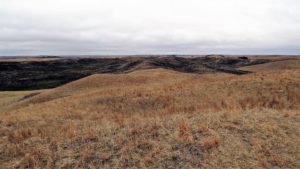 At Calamus Outfitters, we were exposed to the conundrum these lands, and their iconic chickens, now face. Prior to the arrival of European settlers it was the grazing action of bison and elk, combined with the work of dung beetles (not to mention the vast array of other species in the complex) and effects of lightning- and human-kindled grass fires that maintained the treeless and diverse plant communities that thrived here. The prairie chickens thrived with them, existing in hordes that settlers claimed “darkened the skies” and were found “swarming” over the hills. It sometimes seems to me early settlers were a tad prone to hyperbole with such things, but the point is made: there were a lot of prairie chickens. In less fragile soils, where prairies have typically been converted to grain production, the birds are gone now. On well-maintained cattle ranches, they hang on, but do not darken skies or swarm. When ranchers have had to abandon land or have been unable to groom it with tools or fire (in fact, fire has usually been actively suppressed for reasons our culture thinks are obvious), introduced and native local tree species begin to establish in the open areas, providing potential perches for raptors; the grouse and prairie chicken hens instinctively avoid nesting near a perch, so unless the land stays in open prairie, the birds rapidly decline and disappear. So keeping the ranches functioning and healthy is crucial for keeping prairie chickens. Like the cranes, it won’t do to leave them alone, given prevailing land use patterns. But perhaps unlike the crane situation, in the case of the prairie chickens the paradox is nested in a bit more of a complete system, at least on Switzer ranch.
At Calamus Outfitters, we were exposed to the conundrum these lands, and their iconic chickens, now face. Prior to the arrival of European settlers it was the grazing action of bison and elk, combined with the work of dung beetles (not to mention the vast array of other species in the complex) and effects of lightning- and human-kindled grass fires that maintained the treeless and diverse plant communities that thrived here. The prairie chickens thrived with them, existing in hordes that settlers claimed “darkened the skies” and were found “swarming” over the hills. It sometimes seems to me early settlers were a tad prone to hyperbole with such things, but the point is made: there were a lot of prairie chickens. In less fragile soils, where prairies have typically been converted to grain production, the birds are gone now. On well-maintained cattle ranches, they hang on, but do not darken skies or swarm. When ranchers have had to abandon land or have been unable to groom it with tools or fire (in fact, fire has usually been actively suppressed for reasons our culture thinks are obvious), introduced and native local tree species begin to establish in the open areas, providing potential perches for raptors; the grouse and prairie chicken hens instinctively avoid nesting near a perch, so unless the land stays in open prairie, the birds rapidly decline and disappear. So keeping the ranches functioning and healthy is crucial for keeping prairie chickens. Like the cranes, it won’t do to leave them alone, given prevailing land use patterns. But perhaps unlike the crane situation, in the case of the prairie chickens the paradox is nested in a bit more of a complete system, at least on Switzer ranch.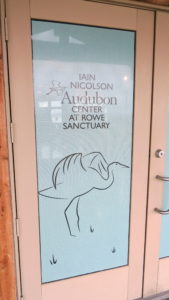 Whereas the crane conservation efforts are headed up by nonprofit foundations entrusted with crane protection and promotion that seek to maintain benign or even mutually beneficial relationships with local grain producers and water regulators, the prairie grouse habitat on Switzer ranch is actively and purposely maintained by the ranching family itself, because through ecotourism they have found a way to turn a natural byproduct of their ranching system—a semblance of ecological integrity—into a source of income. Badly needed income, I might add. Few ranching families are able to make a realistic income from ranching alone these days (the same story as nearly every other sector of family farming), so ranchers are hanging on as precariously as the charming chickens that sometimes populate their beloved acres of prairie. This reality is not lost on the World Wildlife Fund and the Nature Conservancy, both of which have partnered with the Switzer family on habitat projects on the ranch.
Whereas the crane conservation efforts are headed up by nonprofit foundations entrusted with crane protection and promotion that seek to maintain benign or even mutually beneficial relationships with local grain producers and water regulators, the prairie grouse habitat on Switzer ranch is actively and purposely maintained by the ranching family itself, because through ecotourism they have found a way to turn a natural byproduct of their ranching system—a semblance of ecological integrity—into a source of income. Badly needed income, I might add. Few ranching families are able to make a realistic income from ranching alone these days (the same story as nearly every other sector of family farming), so ranchers are hanging on as precariously as the charming chickens that sometimes populate their beloved acres of prairie. This reality is not lost on the World Wildlife Fund and the Nature Conservancy, both of which have partnered with the Switzer family on habitat projects on the ranch.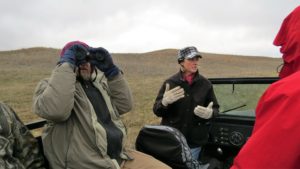 It might be happenstance in this case that what is good for the ranch is what is good for conservation. Certainly human uses of land or other ecosystem interventions (over-hunting comes to mind) conflicting with the needs of native species would seem, if conservation organizations’ literature is to be believed, to be more the norm. But I have my doubts about that way of thinking (I was getting some fun out of asking in otherwise polite conversation around meals which was the better conservationist, the hunter or the birder) and I maintain hope that models like the Switzer ranch, while surely not perfect for the ranchers or the conservationists, represent a microcosm of how we might begin to change our thinking about human involvement in ecosystems. We might learn, if we pay attention, to extract principles from this scenario that could be used to rethink the resource use conundrums that give us such a collective headache.
It might be happenstance in this case that what is good for the ranch is what is good for conservation. Certainly human uses of land or other ecosystem interventions (over-hunting comes to mind) conflicting with the needs of native species would seem, if conservation organizations’ literature is to be believed, to be more the norm. But I have my doubts about that way of thinking (I was getting some fun out of asking in otherwise polite conversation around meals which was the better conservationist, the hunter or the birder) and I maintain hope that models like the Switzer ranch, while surely not perfect for the ranchers or the conservationists, represent a microcosm of how we might begin to change our thinking about human involvement in ecosystems. We might learn, if we pay attention, to extract principles from this scenario that could be used to rethink the resource use conundrums that give us such a collective headache.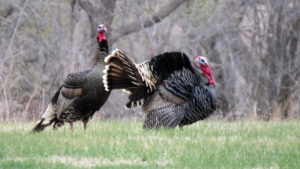 Which brings up an interesting point. Am I not simply suggesting something that the fish and game departments of all the states have been doing for decades now? Why, yes, I think I am, more or less, and it’s been “wildly” successful for several key species (white-tailed deer, wild turkey, black bear come to mind). I never said I was reinventing anything, though I would like to advocate for a much more thoroughgoing engagement that tends to blur the distinctions between promoting wild species and agricultural endeavors. One of our chief tasks now, in my view, is to bring ourselves up to speed on the ways in which we as individuals, as a culture, society, even civilization may already be engaged in parts of this process and then throw our support behind those programs, businesses and efforts, and bring awareness to them. That is to say, go visit your conservation areas, attend those public meetings, read that literature, patronize that integrative farmer, dust off those binoculars, turn over some rocks, sit a while in a place, let your kids run a little wilder. Be a part of the current of humans coming home to roost in the places we belong, our toes in the free water, with each other for raucous companions.
Which brings up an interesting point. Am I not simply suggesting something that the fish and game departments of all the states have been doing for decades now? Why, yes, I think I am, more or less, and it’s been “wildly” successful for several key species (white-tailed deer, wild turkey, black bear come to mind). I never said I was reinventing anything, though I would like to advocate for a much more thoroughgoing engagement that tends to blur the distinctions between promoting wild species and agricultural endeavors. One of our chief tasks now, in my view, is to bring ourselves up to speed on the ways in which we as individuals, as a culture, society, even civilization may already be engaged in parts of this process and then throw our support behind those programs, businesses and efforts, and bring awareness to them. That is to say, go visit your conservation areas, attend those public meetings, read that literature, patronize that integrative farmer, dust off those binoculars, turn over some rocks, sit a while in a place, let your kids run a little wilder. Be a part of the current of humans coming home to roost in the places we belong, our toes in the free water, with each other for raucous companions.